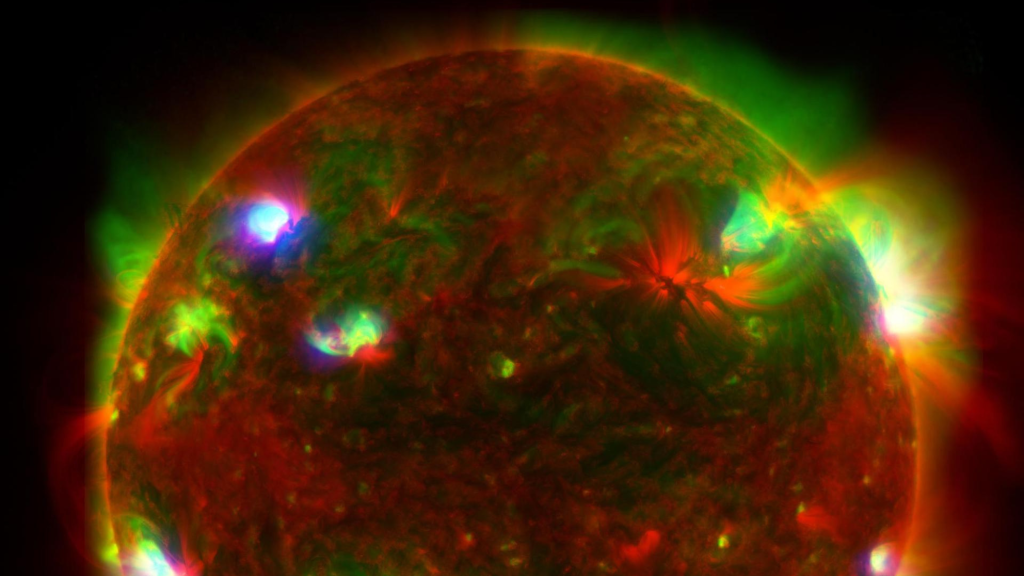The universe is prone to erupting into all kinds of pyrotechnic displays, but gamma-ray bursts are in the top percentile of cosmic kabooms in terms of light and energy. These cataclysmic explosions of light are among the most luminous known events in space, emitting more radiation and energy in seconds than the Sun will over its entire 10-billion-year lifespan.
Now, scientists have announced the discovery of a gamma-ray burst (GRB) with the most energetic radiation ever detected, which goes by the name GRB 190829A after the date it was spotted (August 29, 2019). This exceptional burst emitted photons (light particles) at an astonishing energy level of 3.3 tera-electronvolts (TeV), more than triple that of the next most energetic GRBs on record.
Videos by VICE
The blinding light was caused by a colossal star explosion that took place in a galaxy located about one billion light years away, which actually makes it one of the closest GRBs captured by our telescopes. The dwindling afterglow of the event was visible for three nights, a record-breaking duration of time, and was monitored by the High Energy Stereoscopic System (HESS), a telescope array in Namibia that is operated by an international team of scientists.
“This is really the first time we’ve detected photons at such high energies,” said Sylvia Zhu, lead of the HESS GRB program at Deutsches Elektronen-Synchrotron (DESY) in Germany, in a call. “In the past, when we’ve detected photons of lower, but similar energies, we saw them maybe up to eight hours or so after the birth first began. But this time, we were detecting it over multiple days, which is not something we necessarily expected to be able to do, because they’re hard to detect and they’re rare, anyway.”
“We got really lucky,” she added, “and there was one just right in our backyard that we were able to see for three whole days.”
GRB 190829A’s extreme brightness and unusual proximity enabled the researchers to watch its fade-out in unprecedented detail, an opportunity that revealed “spectral behavior” that “is difficult to describe” using current established models, according to a study published on Thursday in Science authored by the HESS collaboration, including Zhu.
The burst was first spotted by two NASA observatories that orbit Earth, the Fermi Gamma-ray Space Telescope and the Neil Gehrels Swift Observatory, which tracked it to the constellation Eridanus in the southern sky. The source of the explosion is clear: a massive and rapidly rotating star in a distant galaxy had collapsed in on itself, releasing gargantuan amounts of light and energy as its swan song, before turning into a black hole.
The initial detection of the burst triggered follow-up observations from HESS, along with other telescopes on the ground. Zhu said that scientists in her field generally try not to get their hopes up when bursts are first detected, which is perhaps why she recalled the many champagne bottle emojis that turned up in the collaboration’s Slack channel once the exceptional nature of the GRB was confirmed.
“Even after that first initial really exciting moment, it was already sort of all-hands-on-board, trying to figure out what’s the best thing to do afterwards,” she said.
Indeed, the initial explosive output of GRB 190829A was exciting enough on its own, but the real crux of the new paper unfolded over the days following the burst, which the team meticulously monitored. Models of GRBs suggest that X-rays and very-high-energy gamma rays, two forms of light produced by these explosions, should emit different spectral patterns over the course of the wind-down phase, because they are thought to be generated by separate mechanisms.
But that’s not what the HESS collaboration saw in GRB 190829A’s afterglow. The X-ray and gamma-ray signals faded out in sync, hinting that they might be caused by the same underlying process.
“The x-ray and VHE gamma-ray light curves also show similar decay profiles,” the team noted in the study. “These similar characteristics in the x-ray and gamma-ray bands challenge GRB afterglow emission scenarios.”
The unexpected coherence in those bands could lead to new models of GRBs that further elucidate the extreme physics that occur as they flare up and fade. Scientists can mull over possible explanations for the odd finding with theories or simulations, but ultimately, they need to observe more of events like GRB 190829A, which happen to be both hugely energetic and relatively close to Earth. The light from more distant bursts tends to become diluted on its long journey to our planet, making it trickier to study afterglows over a period of days.
“We’re looking forward to finding more,” Zhu said. “In this GRB, we realize that the X-rays and gamma rays at least seemed like they’re coming from the same thing, but is that true for all GRBs or is it just true for this GRB? Is it something about GRB that are close by? Are GRBs that are farther away somehow different in some way?”
Fortunately, there are next-generation telescopes in the works, such as the Cherenkov Telescope Array, that will help the current crop of observatories scour the very-high-energy universe for these events. Gamma-ray bursts elicit both awe and mystery, but scientists hope to be able to unravel the secrets of these mind-bogglingly energetic blowups in the future.
“Once we have more data points, then we can start to really pin down what actually is going on in these GRB jets and in these phenomena,” Zhu concluded.
More
From VICE
-

Photo: Jorge Garc'a /VW Pics/Universal Images Group via Getty Images -

Three-Telescope View of the Sun. Photo: NASA -

Photo: Maria Teresa Tovar Romero / Getty Images -

Photo: grecosvet / Getty Images
